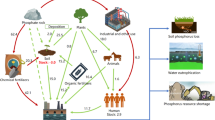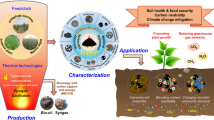Abstract
Aims
The objectives of this research were to determine the optimal pH for maximizing boron (B) accumulation in cattail (Typha latifolia) shoots, and to develop treatment systems for the removal of B from wastewater.
Methods
We performed a hydroponic experiment to examine the effects of pH on shoot B accumulation in cattail plants. Cattails were grown in nutrient solutions containing B at three concentrations (25, 75, and 125 mg B L−1, in the form of H3BO3), supplied at seven pH levels ranging from 4.0 to 10.0. In addition, we compared the effectiveness of B removal by cattails cultured in floating islands and in upward-flow mesocosms.
Results
The effects of pH on growth and B accumulation, although significant, were relatively small compared to the effect of B on the relationship between shoot growth and shoot B accumulation. Cattail floating islands and cattail upward-flow mesocosms reduced concentrations of B in the solutions by 12.5–21.4 % and 12.2–21.3 %, respectively, in the first cycle, and by 11.0–14.2 % and 4.0–13.4 %, respectively, in the second cycle. The higher B removal efficiencies of the floating islands occurred at lower B concentrations, whereas the opposite was observed for the upward-flow mesocosms. Cattails can regenerate rapidly after harvesting of the upper shoots; however, B concentrations in the regenerative upper shoots were found to be lower than that in the first-growth upper shoots.
Conclusions
Optimal pH for shoot B accumulation by cattails is 6.0. Although direct comparisons between the effectiveness of B removal by floating islands and upward-flow mesocosms are difficult, we concluded that upward-flow mesocosms are more suitable for the treatment of B-contaminated wastewater.






Similar content being viewed by others
References
Allende KL, Fletcher T, Sun G (2012) The effect of substrate media on the removal of arsenic, boron and iron from an acidic wastewater in planted column reactors. Chem Eng J 179:119–130
Allende KL, McCarthy D, Fletcher T (2014) The influence of media type on removal of arsenic, iron and boron from acidic wastewater in horizontal flow wetland microcosms planted with Phragmites australis. Chem Eng J 246:217–228
Borne KE, Fassman EA, Tanner CC (2013) Floating treatment wetland retrofit to improve stormwater pond performance for suspended solids, copper and zinc. Ecol Eng 54:173–182
Bouguerra W, Mnif A, Hamrouni B, Dhahbi M (2008) Boron removal by adsorption onto activated alumina and by reverse osmosis. Desalination 223:31–37
Camacho-Cristóbal JJ, Rexach J, González-Fontes A (2008) Boron in plants: deficiency and toxicity. J Integr Plant Biol 50:1247–1255
Craw D, Rufaut C, Haffert L, Todd A (2006) Mobilisation and attenuation of boron during coal mine rehabilitation, Wangaloa, New Zealand. Sci Total Environ 368:444–455
Dannel F, Pfeffer H, Römheld V (1997) Effect of pH and boron concentration in the nutrient solution on translocation of boron in the xylem of sunflower. In: Bell RW, Rerkasem B (eds) Boron in soils and plants. Kluwer Academic Publisher, Dordrecht, The Netherlands, pp. 183–186
Frick H (1985a) Boron tolerance and accumulation in the duckweed, Lemna minor. J Plant Nutr 8:1123–1129
Frick H (1985b) Boron tolerance and accumulation in the duckweed, Lemna minor. J Plant Nutr 8:1123–1129
Garnett TP, Tester MA, Nable RO (1993) The control of boron accumulation by two genotypes of wheat. Plant Soil 155:305–308
Gross A, Shmueli O, Ronen Z, Raveh E (2007) Recycled vertical flow constructed wetland (RVFCW)—a novel method of recycling greywater for irrigation in small communities and households. Chemosphere 66:916–923
Güneş A, Alpaslan M, Çikili Y, Özcan H (1999) Effect of zinc on the alleviation of boron toxicity in tomato. J Plant Nutr 22:1061–1068
Gür N, Türker OC, Böcük H (2016) Toxicity assessment of boron (B) by Lemna minor L. And Lemna gibba L. And their possible use as model plants for ecological risk assessment of aquatic ecosystems with boron pollution. Chemosphere 157:1–9
Hilal N, Kim G, Somerfield C (2011) Boron removal from saline water: a comprehensive review. Desalination 273:23–35
Holloway R, Alston A (1992) The effects of salt and boron on growth of wheat. Crop Pasture Sci 43:987–1001
Hu H, Brown PH (1997) Absorption of boron by plant roots. Plant Soil 193:49–58
Hu GJ, Zhou M, Hou HB, Zhu X, Zhang WH (2010) An ecological floating-bed made from dredged lake sludge for purification of eutrophic water. Ecol Eng 36:1448–1458
Huang JC, Passeport E, Terry N (2012) Development of a constructed wetland water treatment system for selenium removal: use of mesocosms to evaluate design parameters. Environ Sci Technol 46:12021–12029
Kröpfelová L, Vymazal J, Švehla J, Štíchová J (2009) Removal of trace elements in three horizontal sub-surface flow constructed wetlands in the Czech Republic. Environ Pollut 157:1186–1194
Ku WW, Chapin RE, Wine RN, Gladen BC (1993) Testicular toxicity of boric acid (BA): relationship of dose to lesion development and recovery in the F344 rat. Reprod Toxicol 7:305–319
Maine MA, Suñe N, Hadad H, Sánchez G, Bonetto C (2009) Influence of vegetation on the removal of heavy metals and nutrients in a constructed wetland. J Environ Manag 90:355–363
Nable RO, Bañuelos GS, Paull JG (1997) Boron toxicity. Plant Soil 193:181–198
Ning D, Huang Y, Pan R, Wang F, Wang H (2014) Effect of eco-remediation using planted floating bed system on nutrients and heavy metals in urban river water and sediment: a field study in China. Sci Total Environ 485:596–603
Oertli J (1994) Non-homogeneity of boron distribution in plants and consequences for foliar diagnosis. Commun Soil Sci Plan 25:1133–1147
Oertli J, Grgurevic E (1975) Effect of pH on the absorption of boron by excised barley roots. Agron J 67:278–280
Picchioni G, Karaca H, Boyse L, McCaslin B, Herrera E (2000) Salinity, boron, and irrigated pecan productivity along New Mexico’s Rio Grande basin. J Environ Qual 29:955–963
Polowczyk I, Ulatowska J, Koźlecki T, Bastrzyk A, Sawiński W (2013) Studies on removal of boron from aqueous solution by fly ash agglomerates. Desalination 310:93–101
Rees R, Robinson BH, Menon M, Lehmann E, Günthardt-Goerg MS, Schulin R (2011) Boron accumulation and toxicity in hybrid poplar (Populus nigra × euramericana. Environ Sci Technol 45:10538–10543
Robbins WA, Xun L, Jia J, Kennedy N, Elashoff DA, Ping L (2010) Chronic boron exposure and human semen parameters. Reprod Toxicol 29:184–190
Sartaj M, Fernandes L (2005) Adsorption of boron from landfill leachate by peat and the effect of environmental factors. J Environ Eng Sci 4:19–28
Scialli AR, Bonde JP, Brüske-Hohlfeld I, Culver BD, Li Y, Sullivan FM (2010) An overview of male reproductive studies of boron with an emphasis on studies of highly exposed Chinese workers. Reprod Toxicol 29:10–24
Simón I, Díaz-López L, Gimeno V, Nieves M, Pereira WE, Martínez V, Lidon V, García-Sánchez F (2013) Effects of boron excess in nutrient solution on growth, mineral nutrition, and physiological parameters of Jatropha curcas seedlings. J Plant Nutr Soil Sci 176:165–174
Smith T, Grattan S, Grieve C, Poss J, Läuchli A, Suarez D (2013) pH dependent salinity-boron interactions impact yield, biomass, evapotranspiration and boron uptake in broccoli (Brassica oleracea L. Plant Soil 370:541–554
Stiles AR, Bautista D, Atalay E, Babaoğlu M, Terry N (2010) Mechanisms of boron tolerance and accumulation in plants: a physiological comparison of the extremely boron-tolerant plant species, Puccinellia distans, with the moderately boron-tolerant Gypsophila arrostil. Environ Sci Technol 44:7089–7095
Stottmeister U, Wieβner A, Kuschk P, Kappelmeyer U, Kästner M, Bederski O, Müller RA, Moormann H (2003) Effects of plants and microorganisms in constructed wetlands for wastewater treatment. Biotechnol Adv 22:93–117
Takano J, Miwa K, Fujiwara T (2008) Boron transport mechanisms: collaboration of channels and transporters. Trends Plant Sci 13:451–457
Tu KL, Nghiem LD, Chivas AR (2010) Boron removal by reverse osmosis membranes in seawater desalination applications. Sep Purif Technol 75:87–101
Türker OC, Böcük H, Yakar A (2013) The phytoremediation ability of a polyculture constructed wetland to treat boron from mine effluent. J Hazard Mater 252:132–141
Türker OC, Türe C, Böcük H, Yakar A (2014) Constructed wetlands as green tools for management of boron mine wastewater. Int J Phytoremediat 16:537–553
Türker OC, Türe C, Böcük H, Çiçek A, Yakar A (2016) Role of plants and vegetation structure on boron (B) removal process in constructed wetlands. Ecol Eng 88:143–152
Wimmer M, Mühling K, Läuchli A, Brown P, Goldbach H (2003) The interaction between salinity and boron toxicity affects the subcellular distribution of ions and proteins in wheat leaves. Plant Cell Environ 26:1267–1274
Ye Z, Lin ZQ, Whiting S, De Souza M, Terry N (2003) Possible use of constructed wetland to remove selenocyanate, arsenic, and boron from electric utility wastewater. Chemosphere 52:1571–1579
Zhao F, Xi S, Yang X, Yang W, Li J, Gu B, He Z (2012) Purifying eutrophic river waters with integrated floating island systems. Ecol Eng 40:53–60
Acknowledgments
This work was supported by the Electric Power Research Institute, the National Natural Science Foundation of China (Grant No. 41101303), and the China Scholarship Council. We are grateful to Prof. Norman Terry and Dr. Amanda R. Stiles (Department of Plant and Microbial Biology, University of California, Berkeley, USA) for English editing and valuable comments that improved the manuscript.
Author information
Authors and Affiliations
Corresponding author
Ethics declarations
Ethical statement
The authors declare that they have no conflict of interest.
Additional information
Responsible Editor: Robert Reid.
Rights and permissions
About this article
Cite this article
Xin, J., Huang, B. Effects of pH on boron accumulation in cattail (Typha latifolia) shoots, and evaluation of floating islands and upward flow mesocosms for the removal of boron from wastewater. Plant Soil 412, 163–176 (2017). https://doi.org/10.1007/s11104-016-3058-z
Received:
Accepted:
Published:
Issue Date:
DOI: https://doi.org/10.1007/s11104-016-3058-z




